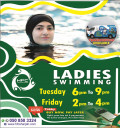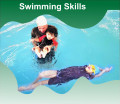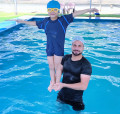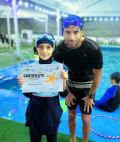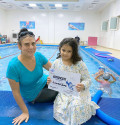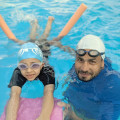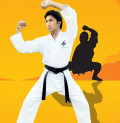
Swimming has a Long History Dating Back to Ancient Civilizations
2022-12-26 - Swimming
Swimming is a popular recreational and competitive sport that has a long history dating back to ancient civilizations. The origins of swimming can be traced back to ancient civilizations in Egypt, Greece, and Rome, where swimming was used as a means of transportation, exercise, and sport. In ancient Greece, swimming was also considered a form of artistic expression.
During the Middle Ages, swimming was largely ignored as a sport and was primarily used for survival and military training. It wasn't until the 19th century that swimming began to gain popularity as a recreational and competitive activity. Swimming was not considered a fashionable or fashionable activity in the past. In the 18th and early 19th centuries, swimming was seen as a lower-class activity, and people of higher social status did not participate in it. As a result, swimming did not gain popularity as a recreational activity until the 19th century, when it began to be seen as a healthy and beneficial activity for people of all social classes.
In 1828, the first modern swimming pool was built in London, which was located at the Royal Baths in Lambeth. It was built to be used for recreational swimming and was open to the public. This marked the beginning of the modern era of swimming, as it provided a place for people to swim for enjoyment rather than just for survival or military training.
Prior to the construction of the Royal Baths in Lambeth, swimming was primarily done in natural bodies of water, such as rivers, lakes, and oceans. The construction of the first modern swimming pool marked the start of a new era in which swimming began to gain popularity as a recreational and competitive activity.
The first swimming club was founded in 1837 and was called the National Swimming Society. It was founded by Captain Matthew Webb, who was a well-known swimmer and the first person to swim the English Channel. The National Swimming Society was dedicated to promoting the sport of swimming and providing a place for people to swim for enjoyment and exercise. The National Swimming Society was the first organization of its kind and played a significant role in the development of swimming as a recreational and competitive activity.
Captain Matthew Webb was a British swimmer who gained fame for being the first person to swim the English Channel. He was born on January 19, 1848, in Dawley, Shropshire, England, and began swimming at a young age. He became a professional swimmer and began competing in long-distance swimming races.
In August 1875, Captain Webb successfully swam across the English Channel, becoming the first person to do so. He completed the 21-mile (34-kilometer) swim in just over 22 hours, using the breaststroke technique. His feat received widespread attention and made him a national hero in England.
After his successful swim across the English Channel, Captain Webb became a public figure and toured the country giving talks and demonstrations. He also wrote a book about his experiences swimming the English Channel. Captain Webb died on July 24, 1883, while attempting to swim across the Whirlpool Rapids below Niagara Falls. Despite his untimely death, Captain Webb remains a significant figure in the history of swimming and is remembered for his contributions to the sport.
Over the years, many other swimming clubs and organizations have been founded around the world, helping to promote and popularize the sport of swimming. Today, swimming is a popular activity around the world, with millions of people enjoying it for its health and fitness benefits as well as for its recreational and competitive opportunities. The modern Olympic Games, which began in 1896, included swimming as one of the sports.
The modern Olympic Games are a major international multi-sport event that features athletes from around the world competing in various sports. The Olympic Games are organized by the International Olympic Committee (IOC),which is headquartered in Lausanne, Switzerland. The modern Olympic Games began in Athens, Greece, in 1896 and have been held every four years since then, except for a few occasions during World War I and World War II.
The first modern Olympic Games included only six sports: athletics (track and field),cycling, fencing, gymnastics, shooting, and swimming. Over the years, the Olympic Games have grown to include a wide variety of sports, with more than 50 sports being included in the most recent Olympic Games. In addition to the sporting events, the Olympic Games also feature cultural events, such as the opening and closing ceremonies, which showcase the culture and traditions of the host country.
The Olympic Games are held in different cities around the world and is a major event that attracts athletes, spectators, and media from all over the globe. The Olympic Games are a symbol of international friendship and cooperation, and they promote the ideals of peace and fair play.
After the inclusion of swimming in modern Olympic games, it has remained a popular and competitive sport at the Olympic Games. Swimming is also one of the most watched and popular sports at the Olympic Games, with millions of viewers around the world tuning in to watch the competition.
Over the years, various strokes and techniques have been developed in competitive swimming, and the sport has become highly specialized. Today, there are several different events in Olympic swimming, including freestyle, backstroke, breaststroke, butterfly, and medley
The oldest strokes in swimming are the breaststroke and the backstroke. The breaststroke is believed to be the oldest stroke, with evidence of it being used as far back as the Stone Age. The breaststroke involves a simultaneous arm stroke and leg kick and is characterized by the swimmer always keeping their head above water.
The backstroke is also an ancient stroke, with evidence of it being used in ancient civilizations. The backstroke involves the swimmer swimming on their back and using an alternating arm stroke and a flutter kick. Both the breaststroke and the backstroke were originally used as a means of transportation and to cross bodies of water. They were also used for exercise and recreation. Over time, these strokes were developed and refined, and they became an important part of competitive swimming. Today, the breaststroke and the backstroke are two of the four main strokes in competitive swimming, along with the freestyle and the butterfly.
The origins of the freestyle stroke can be traced back to the 19th century when it was developed to swim more efficiently and quickly. The butterfly stroke, on the other hand, has a more recent history, with evidence of it being used in competitive swimming in the early 20th century. The butterfly stroke was developed by American swimmer Jack Sieg, who first used it in competition in 1933. Sieg was born in 1908 and began swimming at a young age. He became a competitive swimmer and began using the butterfly stroke, which was controversial at the time, as it was a new stroke that had not been seen before. However, Sieg's use of the stroke helped to popularize it, and it was eventually accepted as a legitimate stroke in competitive swimming.
Sieg continued to compete in swimming events and was a member of the United States Olympic team in the 1936 Berlin Olympics. He also set a number of world records in the butterfly stroke. Sieg died in 1989, but his contributions to the sport of swimming are remembered and recognized today. The butterfly stroke is now one of the four main strokes in competitive swimming, along with freestyle, backstroke, and breaststroke. The stroke was later refined and became a part of competitive swimming. Today, both the freestyle and butterfly strokes are important and popular strokes in competitive swimming.
Swimming has come a long way, becoming a popular activity on account of its health and fitness benefits. It also gained popularity for it is a low-impact activity that can be enjoyed by people of all ages and abilities. Swimming is also an excellent cardiovascular workout that can help to improve overall health and fitness.
Swimming has gained immense popularity as a competitive sport governed by national and international organizations, in addition to its being a popular recreational and fitness activity. There are many different competitive swimming events and leagues, which includes the Olympic Games, the World Aquatics Championships, and the FINA World Swimming Championships. These events feature top swimmers from around the world competing in various strokes and events.
.







.jpg)





















































